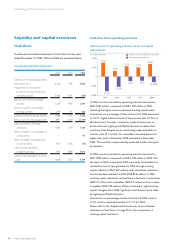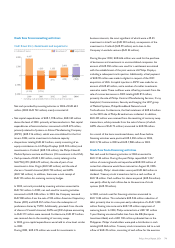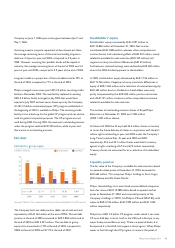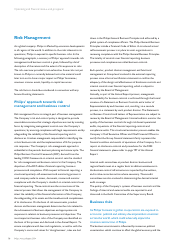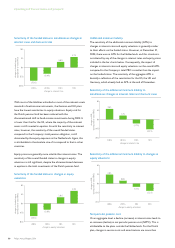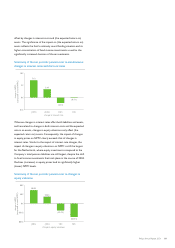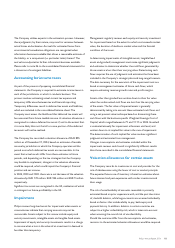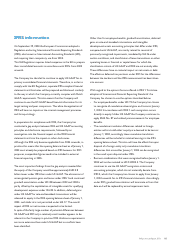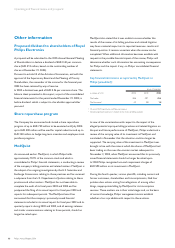Philips 2004 Annual Report Download - page 80
Download and view the complete annual report
Please find page 80 of the 2004 Philips annual report below. You can navigate through the pages in the report by either clicking on the pages listed below, or by using the keyword search tool below to find specific information within the annual report.litigation cannot be determined due to a number of variables, the
Company’s financial position and results of operations could be
affected by an adverse outcome. Please refer to note 26 of the
consolidated financial statements for the disclosed litigation
matters.
Philips has defined-benefit pension plans in a number of
countries. The cost of maintaining these plans is influenced
by fluctuating macro-economic and demographic
developments, creating volatility in Philips’ results.
The majority of employees in Europe and North America are
covered by these plans. The accounting for defined-benefit pension
plans requires management to make assumptions regarding
variables such as discount rate, rate of compensation increase and
expected return on plan assets.
Changes in these assumptions can have a significant impact on the
projected benefit obligations, funding requirements and periodic
pension cost. A negative performance of the capital markets could
have a material impact on pension expense and on the value of
certain financial assets of the Company. For a discussion of
pension-related exposure to changes in financial markets, please
refer to the sensitivity analysis presented hereafter, and for
quantitative and qualitative disclosure of pensions, please refer to
note 20 of the consolidated financial statements.
Pension-related exposure to changes in financial
markets
With pension obligations in more than forty countries, the
Company has devoted considerable attention and resources to
ensuring disclosure, awareness and control of the resulting
exposures.
Depending on the investment policies of the respective pension
funds, the value of pension assets compared to the related pension
liabilities, and the composition of such assets, developments in
financial markets may have a significant effect on the funded status
of the Company’s pension plans and their related pension cost. To
monitor the corresponding risk exposure, a ‘Global Risk Reward
Model’ for pensions has been developed. The model, which covers
approximately 95% of total pension liabilities and contains separate
modules for the Netherlands, the UK, the US and Germany, allows
estimates of the sensitivities to changes in equity market valuations
and interest rates.
The bar charts in the sections hereafter show the estimated
sensitivities to interest rates and equity market valuations for the
Netherlands, the UK, the US and Germany, on aggregate, based
upon the assets, liabilities, discount rates and asset allocations as of
December 31, 2004. They show how much the aggregate funded
status and additional minimum liability would have differed from
what they actually were, if interest rates or equity valuations had
been lower or higher, and to what extent net periodic pension
cost (NPPC) for 2005 would have been affected. All results are
shown as a percentage of total projected benefit obligations (PBO,
amounting to EUR 19.5 billion) or total NPPC (estimated to be
EUR 235 million). The interest rate sensitivities have been
estimated on the assumption that interest rates and discount rates
change simultaneously. The estimated sensitivities presented do
not reflect the correlation, if any, between changes in interest
rates and equity market valuations.
Funded status
A change in interest rates affects the values of both assets and
liabilities, whereas changes in equity valuations affect asset values
only. Generally speaking, the interest rate sensitivity of the
liabilities tends to be significantly greater than the sensitivity of
pension assets. Consequently, decreases in interest rates tend to
have detrimental effects on the funded status of a plan.
As of December 31, 2004, for Company-sponsored plans, 57% of
pension assets were invested in fixed-income securities, an
increase of 9% over the prior year. There was a corresponding
decrease in equity securities. This change was a result of actions
taken by the Dutch pension fund to reduce its interest rate
sensitivity. Although in relative terms the sensitivity of the Dutch
pension plan’s funded status is lower than the sensitivity of other
major Company-sponsored plans, due to the relative size of its
pension liabilities (which cover 64% of the total PBO for the
Company), the interest rate risk for the Dutch pension plan
compared to the Company’s total pension obligations is still larger
than that for the other countries.
79Philips Annual Report 2004



